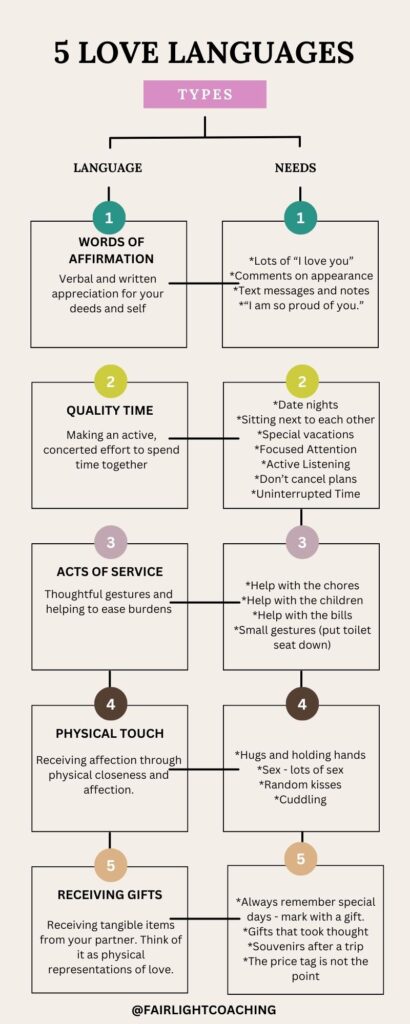The 5 Love Languages


Welcome to my series on Relationships: Communication. In today’s session we’re going to discuss the 5 Love Languages and what barriers and conflicts may arise in your relationship because of them.
Does it sometimes feel like your partner is missing the mark when trying to connect with you? As the days (or years) pass this can lead to feelings of resentment and a “love cup” that is running empty. As humans we are motivated and bound by love and connection, so when these cups run empty, we can lose our way. If this is the case – it’s possible that you and your partner may have different ideas of what it means to show love and be loved.
History of Love Languages
This concept was first introduced by marriage counselor and minister Gary Chapman in his 1992 book entitled, “The Five Love Languages: How to Express Heartfelt Commitment to Your Mate.” )
The main concept behind his book was the misinterpreting of intentions (and needs) by our partners and how that can lead to a disconnect. There’s been some back and forth within the psychology community about its validity, but the truth remains that communicating our needs and being heard is one of the most important aspects of a relationship.
And frankly, when humans feel their needs are being met – we’re more amiable, more willing to give to others, and are more fulfilled.
The 5 Love Languages
1. Words of Affirmation:
If you have this main language, your proverbial love cup is filled when you receive spoken words of praise and appreciation. These can be put into practice by showing verbal appreciation for deeds, appearance, and the vocalization of feelings.
2. Quality Time:
You want focused attention from your partner. You need active listening and love a good date night.
3. Acts of Service:
Life can be overwhelming with responsibilities and chores. In this love language, you feel loved when your partner helps you with chores, bills, and childcare.
4. Physical Touch:
These love languages need physical affection to feel loved. They want random kisses and hugs, holding hands on a date, and plenty of intimate time.
5. Receiving Gifts:
Don’t mistake this love language for materialism. It’s about having a tangible, physical representation of your partner’s feelings. They remember special occasions and mark them with gifts (handmade or bought), flowers, date, and trips. It’s not about the price tag.
Quickstart Ideas for Using Love Languages
1. Words of Affirmation:
- Compliments on appearance or accomplishments (however large or small)
- Frequent encouraging text messages or note, such as: “Thank you for this meal” or “You look beautiful/handsome.”
2. Quality time:
- Date nights
- Practice Active Listening at the end of the day – Tell me about your day
3. Acts of Service:
- Help with chores without being asked
- Do chores together
- Give your partner a night off
4. Physical Touch:
- Hold hands on a walk
- Run your hands through their hair
- Give spontaneous hugs
- Initiate intimate time
5. Receiving Gifts:
- Write special days in your calendar
- Bring back souvenirs from trips
How Love Languages Form
We may feel like we have “moved on” past childhood traumas, but this is a limited view on the scope of trauma. Our childhoods are what form our lenses of the world. They create the languages that we speak, and this is seen in a macro version of the romantic relationships we hold. Early patterns can play out beneath the surface, which is why figuring out your own love language can be such a powerful tool.
“People tend to criticize their spouse most loudly in the area where they themselves have the deepest emotional need.”
– Gary Chapman
Love Language Quiz
To find a free quiz to access your own love language, you can visit:
https://5lovelanguages.com/quizzes/love-language
This site was made by the founder of these concepts, Gary Chapman, and will give you your main love language for free. A more in-depth analysis costs a bit more, but this is a good starting point.
Communication is Key
In order to put these concepts into practice, it’s of such importance that you have open communication with your partner about what your needs are. This starts with you yourself understanding what it is you need.
It may not be obvious to your partner that your needs are different than theirs. We tend to look at the world with a myopic view. Clearly communicating what your love language is and giving a few examples to your partner can make a significant difference. Be sure to do this during peaceful times when everyone’s nervous system is regulated.



